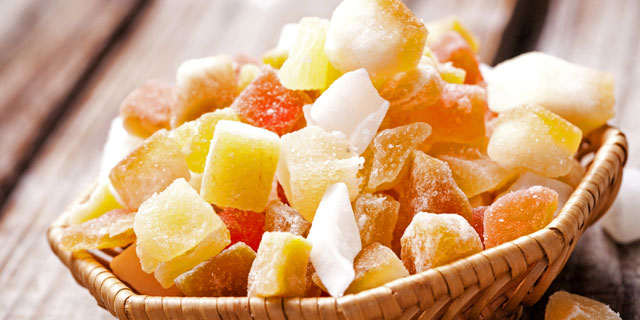It's summer and ripe, sweet, colorful fruits are easy to come by. Everywhere you turn there are bushels of raspberries, bunches of grapes, and piles of watermelon. But there’s only so much delicious, fresh fruit you can fill up on. Instead of letting the fruit languish on your kitchen counter, dry it or make candy out of it. Candied cherries, tangy apricots…the possibilities are endless!
Drying fruit or turning it into candy is easier than you may you think. TLK spoke with Brad van Dam, CEO of Marich Confectionery. Having been in the candy business for more than 20 years, his tips are essential to making DIY fruit candies.
To start, hit the green market! You want fruit that is perfectly ripe and blemish free. Van Dam likes cherries, blueberries, cranberries, California apricots, and mango. After you’ve selected your fruit, prepare it just like you would if you were to eat it. Wash it, slice it, and decide which prep suits you most: dried fruits or sweet candied fruits!
Next, how to get started… [pagebreak]
Dried Fruit
After you’ve prepared your fruit, fire up your burners. Store bought dried fruit uses sulfur to retain color (hello, orange apricots!) but at home, simply blanch your fruit to help it keep its bright hue and shape. There are two ways to do this.
You can steam the fruit for 30 seconds and then place it in cold water for 30 seconds or soak the fruit in lemon juice and water (about 1 teaspoon of lemon juice for each quart of water) for 10 minutes, then blot and dry it. Just remember that depending on the density of the fruit you use the lemon juice may give the fruit a citrus flavor.
Now, your fruit is ready to dry. Again you have several options. If you’re going to make a lot of dried fruit, invest in an electric dehydrator, you can pick one up for about $50 at your favorite kitchen store. The other options are to use an oven or the sun.
Drying Fruit in the Oven
This is the easiest way to dry fruit. Simply place the blanched fruit on parchment lined cookie sheets. Set the oven to about 145 degrees and rotate the fruit every two hours until it's done.
Drying Fruit in the Sun
This method isn't easy or quick! You'll need to live in a place with temperatures that are consistently above 80 degrees, where there is little to no humidity, and where you can guarantee that the fruit won't be contaminated by insects or wildlife. If you want to give it a go, place blanched fruit on parchment lined cookie sheets and place it in the sun, then flip once a day.
When is it Done?
So when is your fruit ready? Touch it! It should feel dry but not brittle. Most dried fruit, if stored in an airtight container, can last from three to six months.
Next, how to candy fruit… [pagebreak]
Candied Fruit
Making candied fruit is similar to drying fruit except that you are replacing the water the fruit loses during the drying process with sugar. To do this, start by combining sugar and water in a saucepan and bringing the temperature to a boil. For every 1/2 cup of sugar, use 1-1/2 cups of water.
After the sugar has dissolved and you have a clear simple syrup, add in sliced fruit and turn the heat down to a medium to low heat. Cook until the fruit turns translucent; this will take anywhere from 20 to 50 minutes depending on the fruit.
Place the fruit on a rack to cool (this gets messy so place parchment paper under the rack), then once dry, roll in sugar. Store in an airtight container between wax paper and the fruit should last for six months.
Which Fruits to Use
Start with your favorite fruits, but keep in mind that fruits that make good candy don’t always dry well. Blueberries, according to van Dam, are best as candies.
“Due to the need for a bit more structure they are almost always infused with either sugar or high fructose corn syrup,” van Dam said.
Cherries on the other hand work better dried, especially when added to baked goods, salads, and even in meat based dishes.
Feeling tropical? “When it comes to tropical fruits we like mango the best,” van Dam said. “They're tasty and have a great chewy texture to them.”
Now, start experimenting and find your own favorites!


![Making Mealtime Matter with La Familia: Easy Sofrito [Video]](https://thelatinkitchen.com/wp-content/uploads/2015/10/sofrito-shutterstock__0-500x383.jpg)
![Easy Latin Smoothies: Goji Berry Smoothie [Video]](https://thelatinkitchen.com/wp-content/uploads/2015/12/goji_berry-shutterstock_-500x383.jpg)
















![Fun and Fast Recipes: Fiesta Cabbage Salad [Video]](https://thelatinkitchen.com/wp-content/uploads/2015/11/fiesta_cabbage_slaw-shutterstock_-500x383.jpg)









